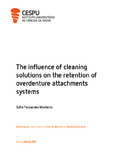The influence of cleaning solutions on the retention of overdenture attachments systems
Resumo
Dental-implant-supported reconstructions provide comfort and improvements in prosthetic
function, adaptation, and stability over conventional treatment options.
The objective of this study was to evaluate the effect of different denture cleansing
solutions and their influence on the deterioration and loss of retention of overdenture
attachments in a 12-month clinical-use simulation. In this way, ten specimens each of
different brands of retentive caps made of Teflon (OT Equator® (Rhein83, Bologna, Italy),
Locator® (Zest Anchors, Escondido, CA, USA), Kerator® (KJ Meditech, Gwangiu, Republic of
Korea), and Locator R-Tx® (Zest Anchors, Escondido, CA, USA)) were immersed in five
different cleaning solutions (Kukident® (P&G Tech, Oxford Parkway, UK), Benfix®
(Laboratorios URGO S.L., Guipúzcoa, Spain), Corega® (Stafford Miller, Waterford, Ireland), and
Protefix® (Neuhofer Weiche, Parchim, Germany)), and tap water was used as the control
group, in a simulation that lasted 12 months.
Data were analyzed using two-way ANOVA and a Tukey HSD. Furthermore, a Levene Test and
Shapiro–Wilk tests were performed to assess the validation of the ANOVA assumptions. The
statistical analysis was performed using R version 4.2.2 software with the significance level
set to p < 0.05.
There were significant statistical differences between the different manufacturers regarding
the retention forces of the attachment’s retentive caps (F = 322.066, p < 0.001). For the
cleaning solution groups, different statistical results between Kukident® (P&G Tech, Oxford
Parkway, UK) (p < 0.05) and Benfix® (Laboratorios URGO S.L., Guipúzcoa, Spain) (p < 0.05)
were observed. There were no significant statistical differences between Corega® (Stafford
Miller, Ireland), Protefix® (Neuhofer Weiche, Parchim, Germany), and tap water, even though
the retention forces decreased in all of them.

